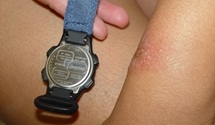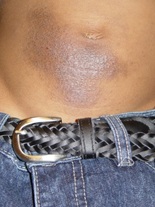Definition
Contact dermatitis is a form of exogenous (external) dermatitis or eczema. Contact dermatitis is divided to allergic contact dermatitis and irritant contact dermatitis. It is an inflammatory reaction of the skin caused by direct contact with certain substances called allergens (haptens) in allergic contact dermatitis or irritant in irritant conatact dermatitis. The skin reaction will present itself as eczema or dermatitis, resulting in itch, dry, redness and blisters of the skin.
 |
| Figure 1: Contact Dermatitis to nickel containing watch |
What commonly cause contact dermatitis?
Common haptens (allergens) that can cause inflammation of the skin are listed below:
- Rubber additives or chemicals in gloves, tools with rubber handles, gym equipment or bike handles.
- Fragrances in perfumes, deodorants, shampoos, soap bar or lotions and cosmetics.
- Various types of traditional oil base topical medications
- Nickel containing items in costume jewellerieseg: brooch or necklace, wrist watch, studs in jeans, belt buckle and spectacle.
- Various types of industrial chemicals at workplace.
Common irritants that can cause inflammation of skin are listed below:
- Detergents in dish washing liquids or soap bar and floor cleansers
- Solvents
- Physical factors such as heat, friction, repetitive pressure, low or high humidity eg: wet work etc.
What are the common presentations of contact dermatitis?
- The areas affected will depend upon the areas of contact.The commonest areas affected are the hands, arms, neck, face and legs.
- In the early (acute) stage, they commonly present with itchiness, small red bumps or tiny water blisters of the skin. These blisters will rupture and the skin will become weepy or crusted.
- In the later (chronic) stage, they commonly present with itchiness, darker brown to slightly blackish pigmentation, thickening and slight scaling of the skin.
 |
| Figure 2: Contact dermatitis to nickel in belt buckle |
Treatment
- The main treatment is to avoid direct contact with allergens and irritants. Patch test is the appropriate test to detect allergens.
- Early stage:
- Frequent soak or dab with potassium permanganate for weepy or wet skin lesions. This is usually carried out for 2 to 3 days.
- Apply topical steroid cream daily or twice a day as prescribed by your doctor. It helps to reduce the inflammation.
- Antihistamines may be helpful in some patients to reduce the itchiness.
- Later stage:
- Apply topical steroid cream daily or twice a day as directed by your doctor.
- Apply moisturiser in the form of cream or ointment to improve the dry skin or scaly lesions.
- Antihistamines may be helpful in some patients to reduce the itchiness.
- Antibiotics are only given by your doctor if lesion is suspected to have superimposed bacterial infection.
Preventive Measures
- It is important to avoid the causative allergens or irritants, if you are aware of the cause, to prevent recurrence.
- Use proper personal protective equipment at workplace as instructed by your supervisor.
- Advice on care of your hands includes:
- Do not soak or keep your hands wet for a long period of time
- Reduce frequent hand washing
- Use gloves when handling chemicals or detergent
- Use mild detergent when washing dishes
- Dry hand thoroughly after washing
- Use moisturiser and apply it frequently
| Last Reviewed | : | 23 August 2019 |
| Writer | : | Datin Dr. Asmah bt. Johar |
| Accreditor | : | Datuk Dr. Roshidah bt. Baba |
| Reviewer | : | Dr. Nazatul Shima bt. Abd Rahim |







